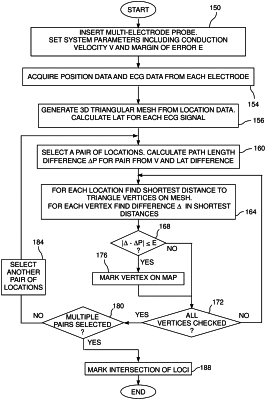| CPC A61B 5/062 (2013.01) [A61B 5/0042 (2013.01); A61B 5/0044 (2013.01); A61B 5/0538 (2013.01); A61B 5/283 (2021.01); A61B 5/287 (2021.01); A61B 5/364 (2021.01); A61B 5/4836 (2013.01); A61B 5/7235 (2013.01); A61B 5/743 (2013.01); A61B 18/12 (2013.01); A61B 34/20 (2016.02); G06T 17/20 (2013.01); A61B 5/6847 (2013.01); A61B 2018/00351 (2013.01); A61B 2018/00577 (2013.01); A61B 2018/00595 (2013.01); A61B 2018/1467 (2013.01); A61B 2034/2046 (2016.02); A61B 2576/023 (2013.01); G06T 2210/41 (2013.01)] | 5 Claims |

|
1. A method, comprising:
inserting a probe into a chamber of a heart of a human subject, the probe comprising at least two pairs of electrodes at a distal end thereof;
generating location signals indicative of location coordinates of the distal end of the probe;
acquiring from positions on a surface of the chamber respective electrical signals in response to a conduction wave traversing the surface;
processing the location signals to generate and present on a display a three-dimensional (3D) representation of the surface;
deriving respective local activation times (LATs) from the respective electrical signals at the positions on the surface;
calculating a first time difference between the respective LATs at a first pair of the positions on the surface and a second time difference between the respective LATs at a second pair of the positions on the surface;
calculating first and second LAT-derived distances as respective products of the first time difference and the second time difference with a conduction velocity of the conduction wave;
identifying an origin of an arrhythmia at a location on the surface such that a first difference in distances over the surface from the location to the first pair of the positions is equal to the first LAT-derived distance, and a second difference in distances over the surface from the location to the second pair of the positions is equal to the second LAT-derived distance;
marking the identified origin on the representation of the surface on the display;
generating a triangular mesh from the location coordinates, and wherein the distances over the surface comprise shortest distances measured along edges of the mesh;
covering the triangular mesh to form a smooth continuous 3D surface;
displaying a graphic representation of the smooth 3D surface on the display;
specifying equally spaced sample points on the triangular mesh; and
using the sample points to perform discrete calculations on the continuous 3D surface.
|